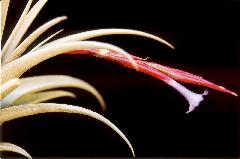
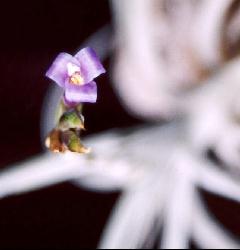
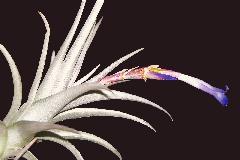
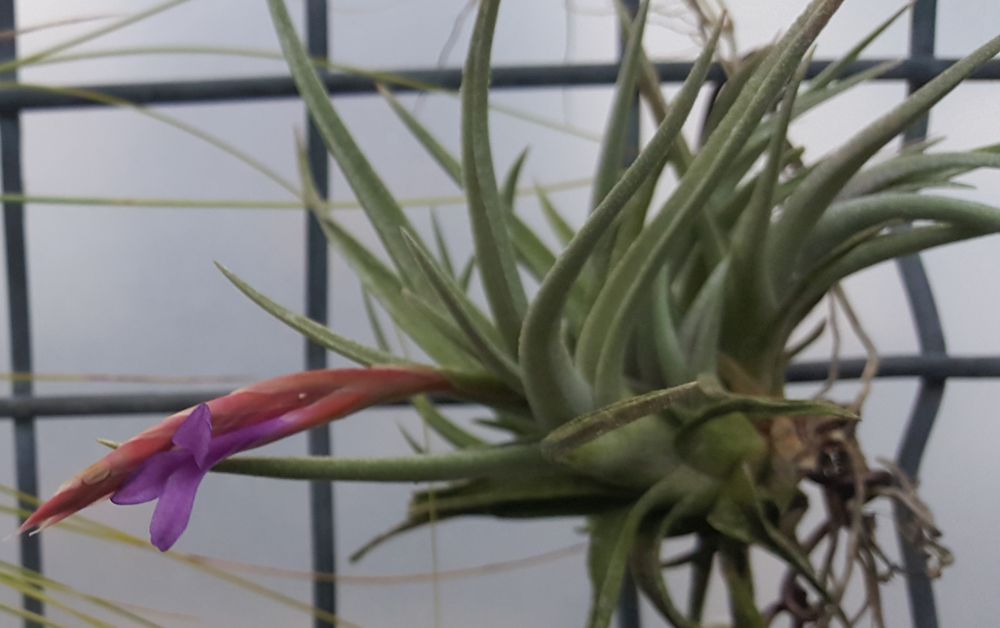
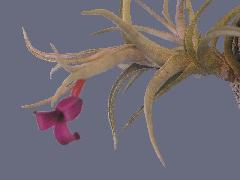
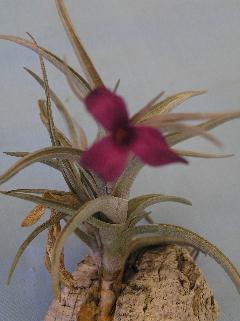
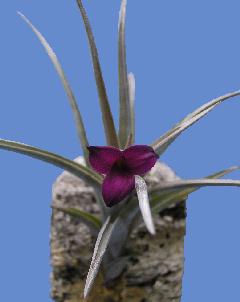
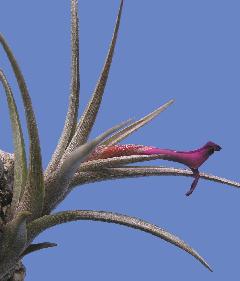
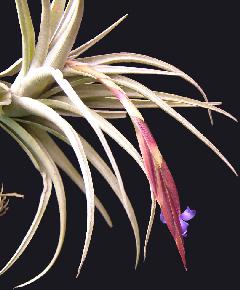
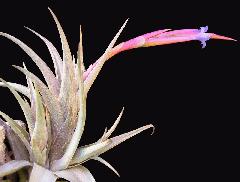
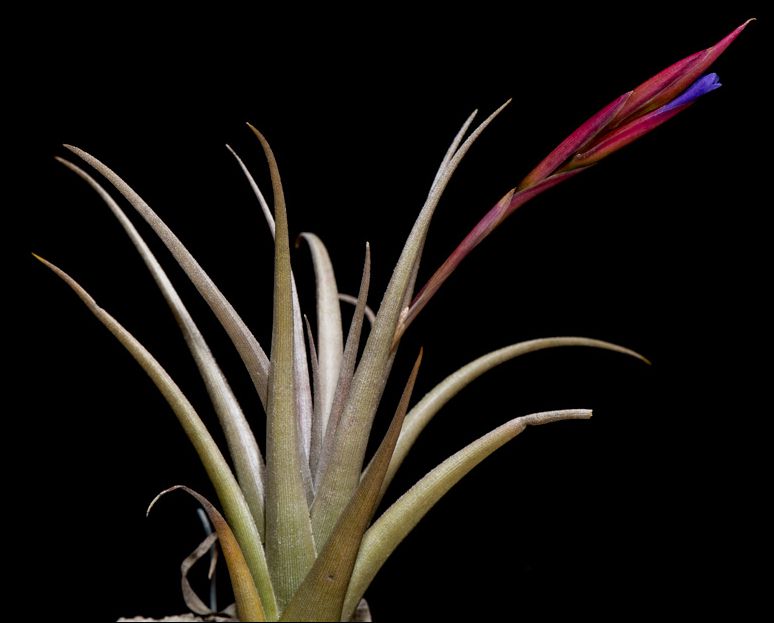
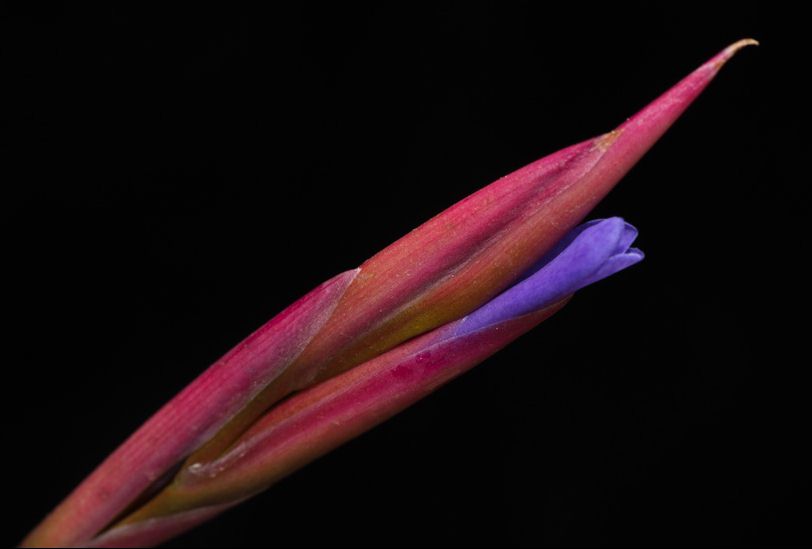

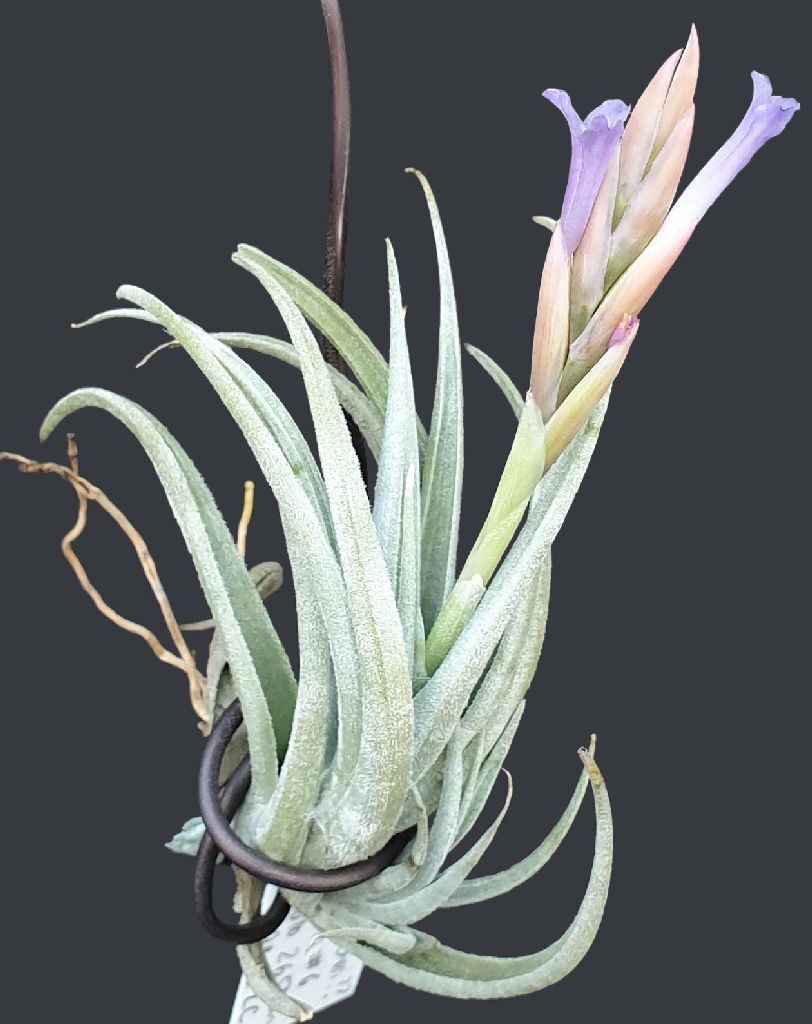
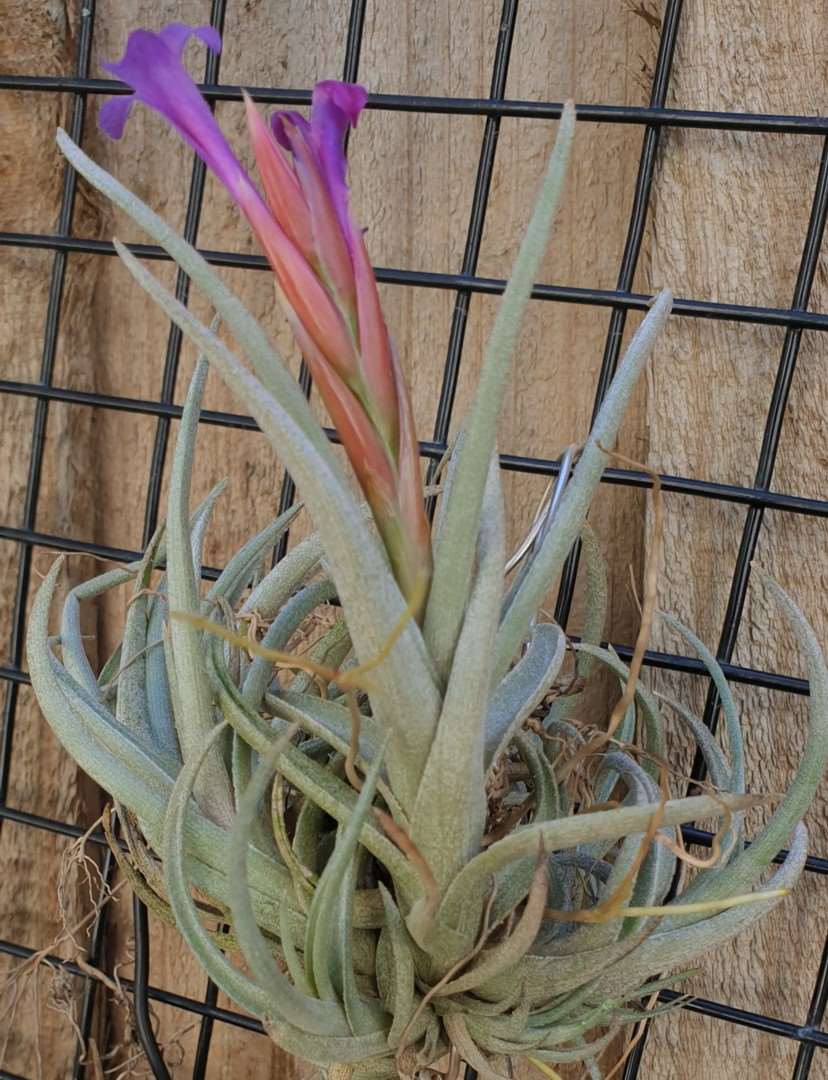
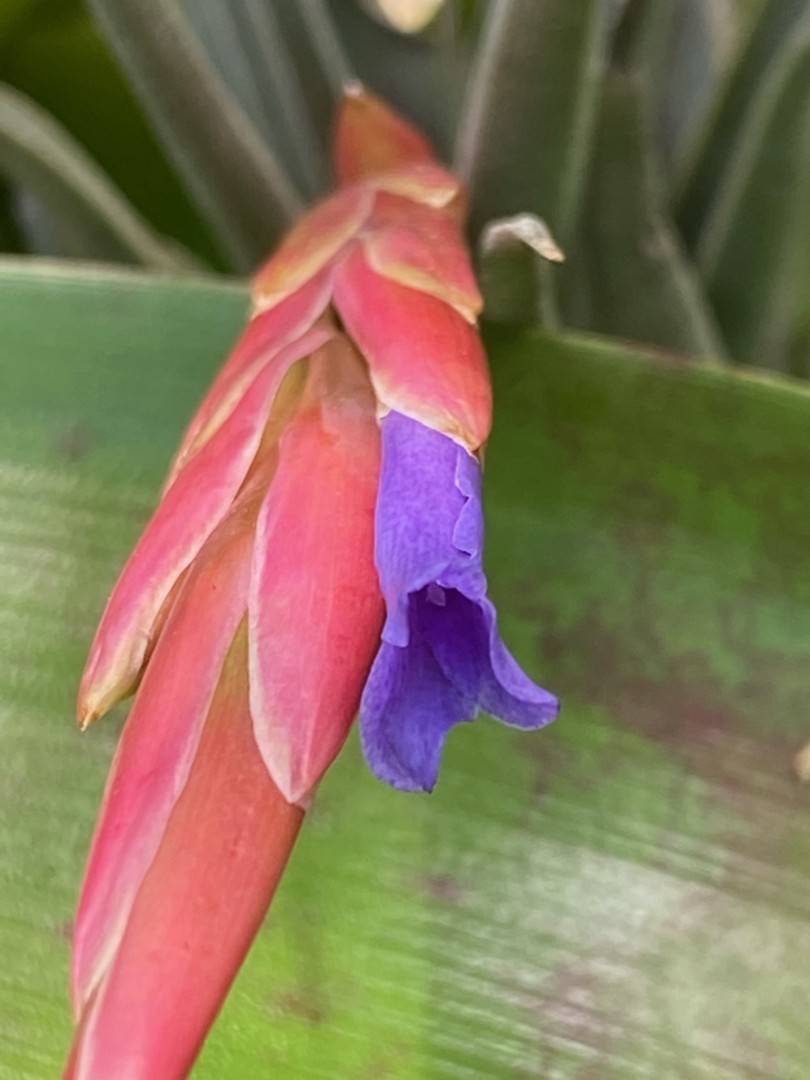
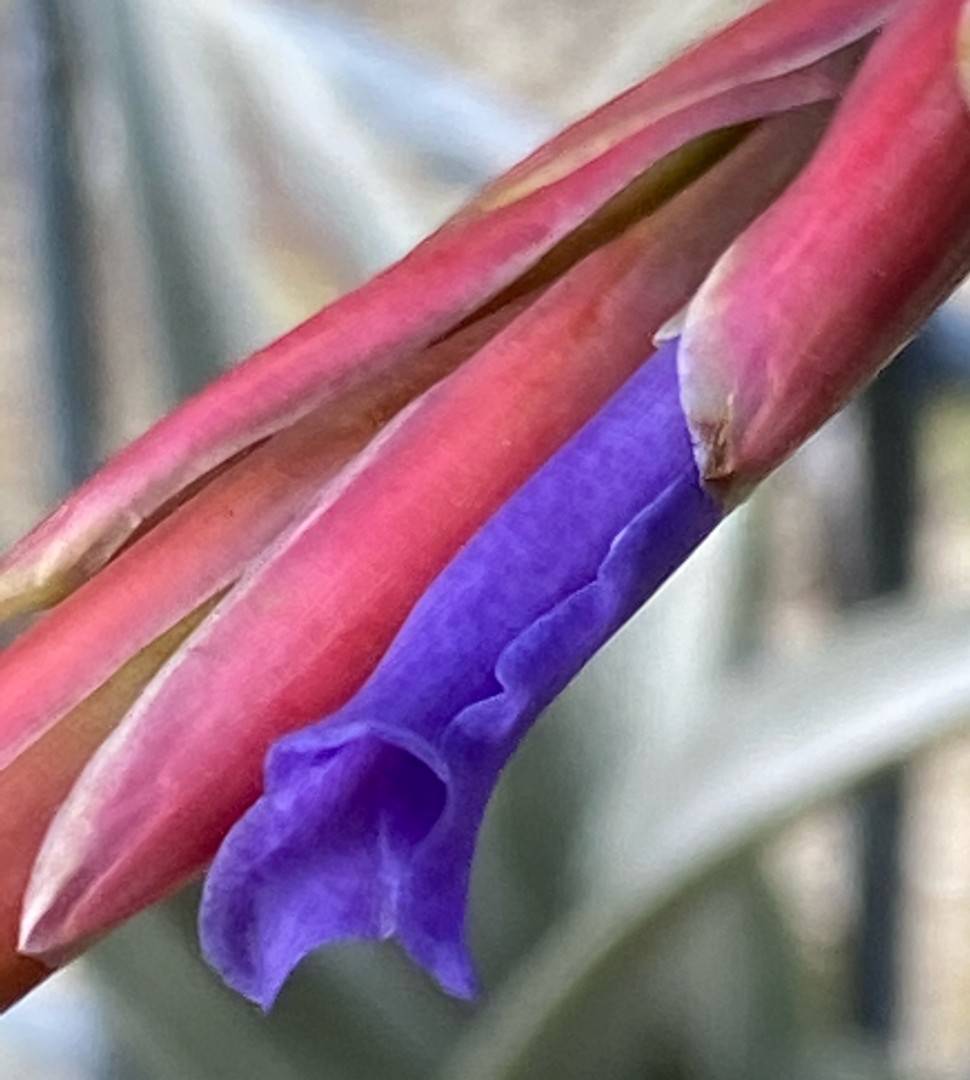
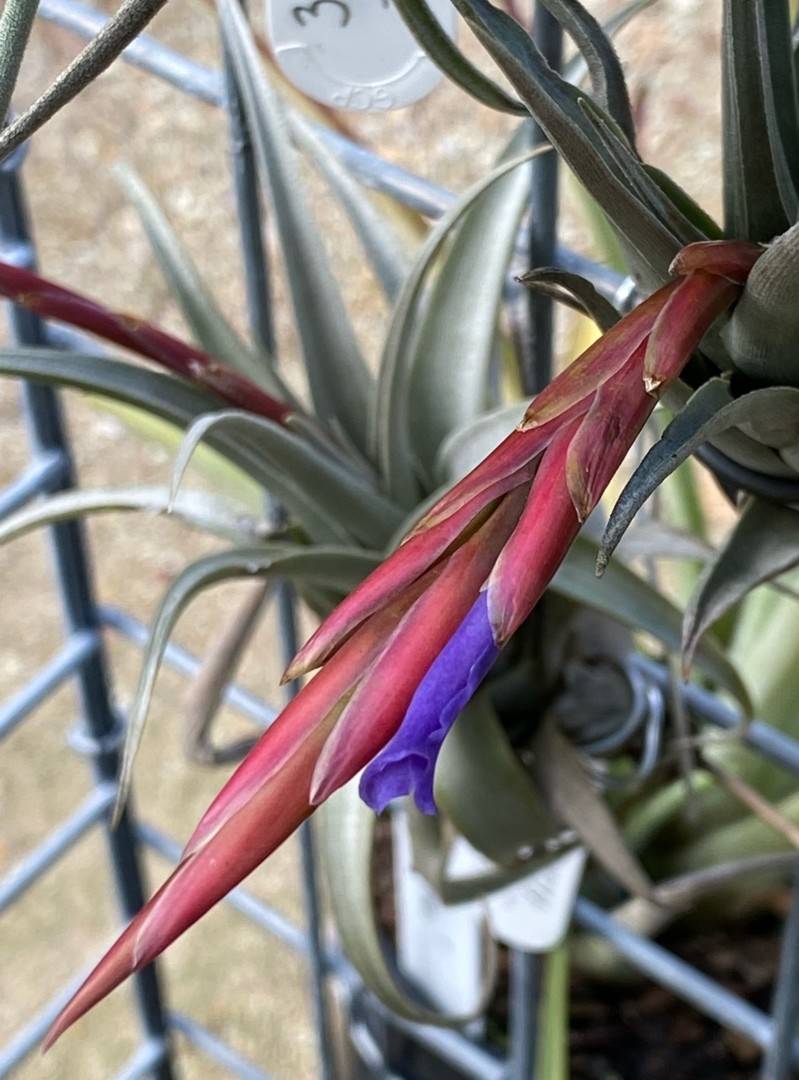
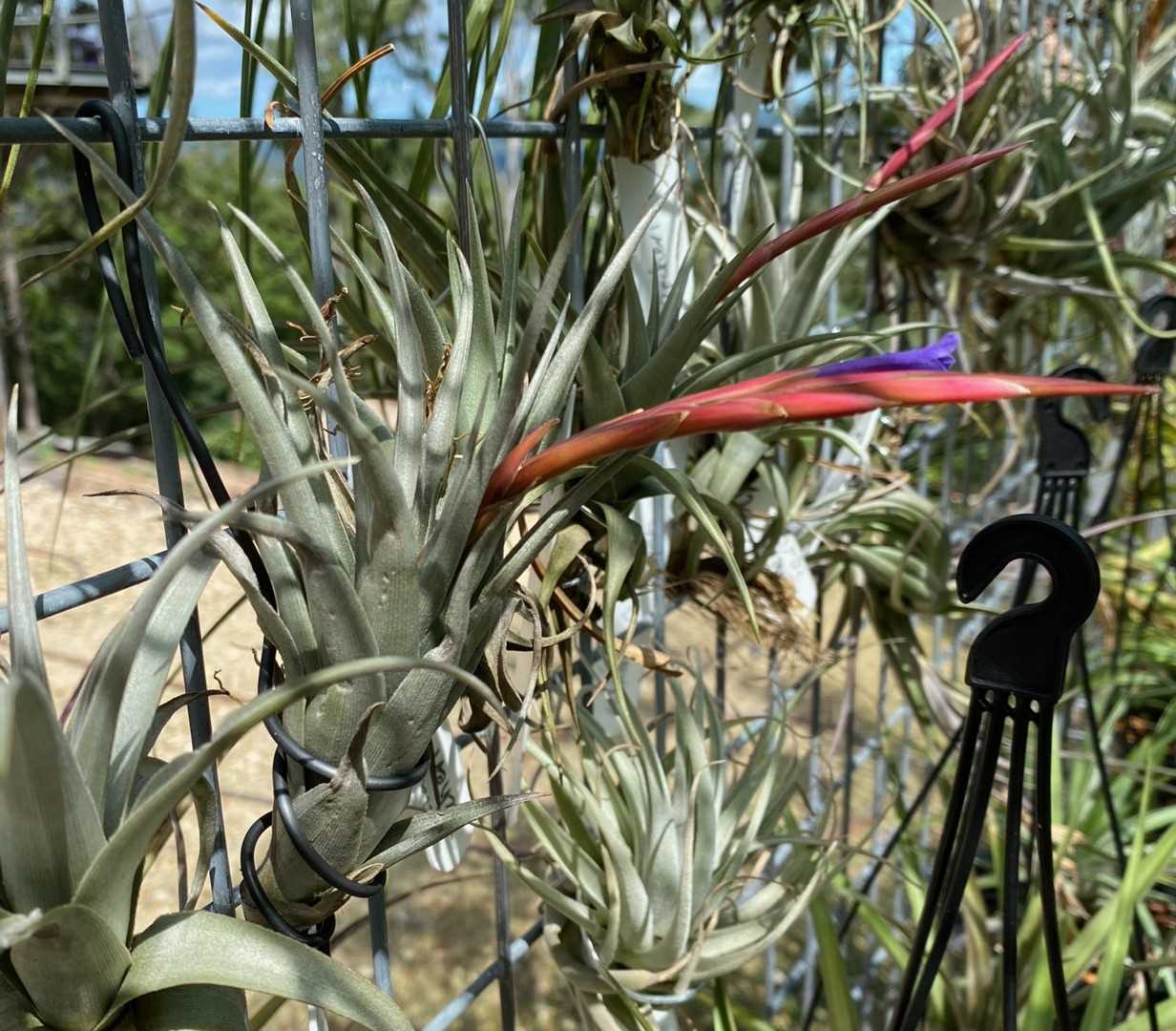
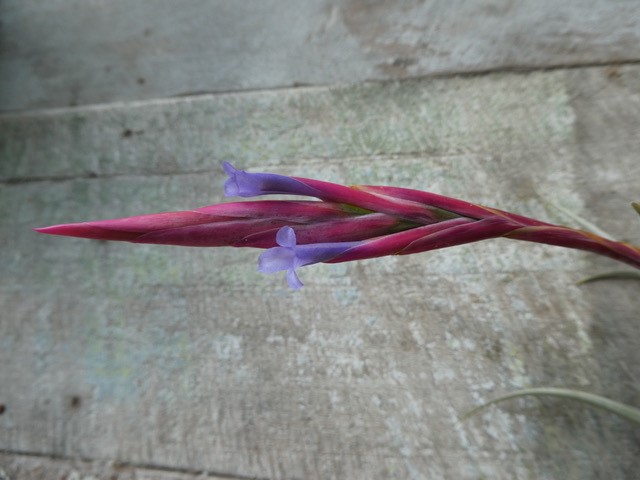
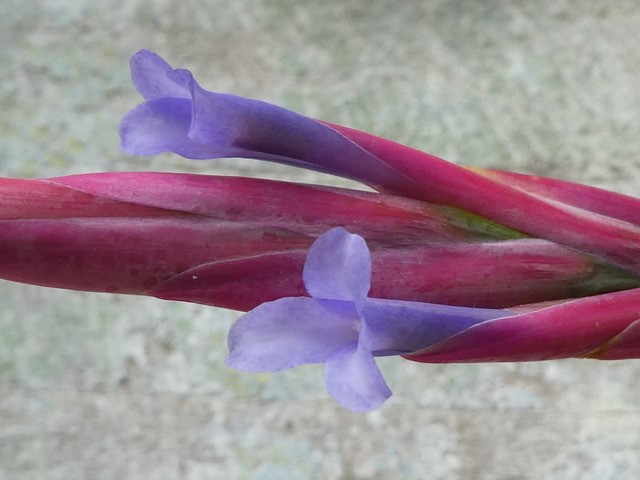
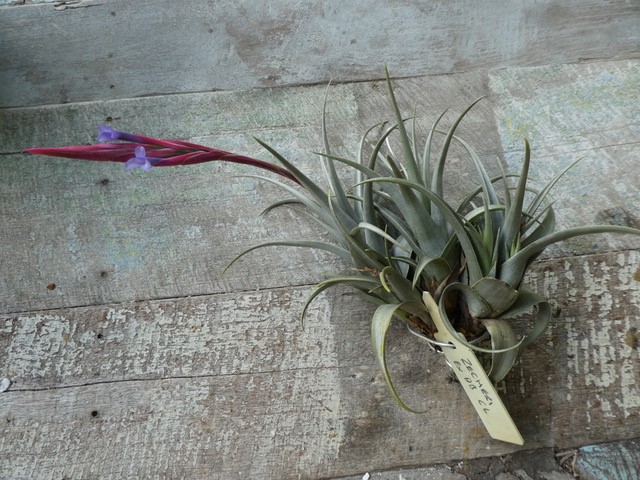
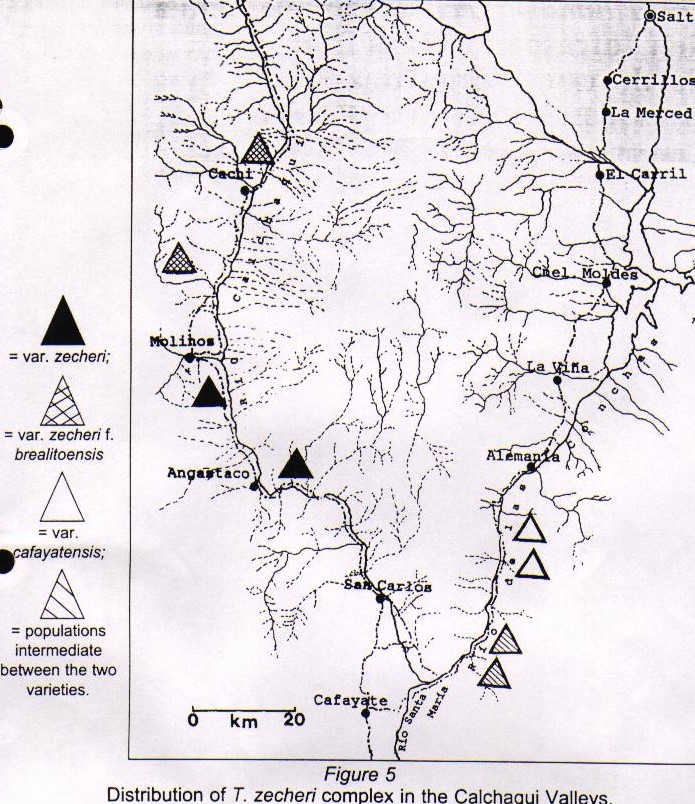
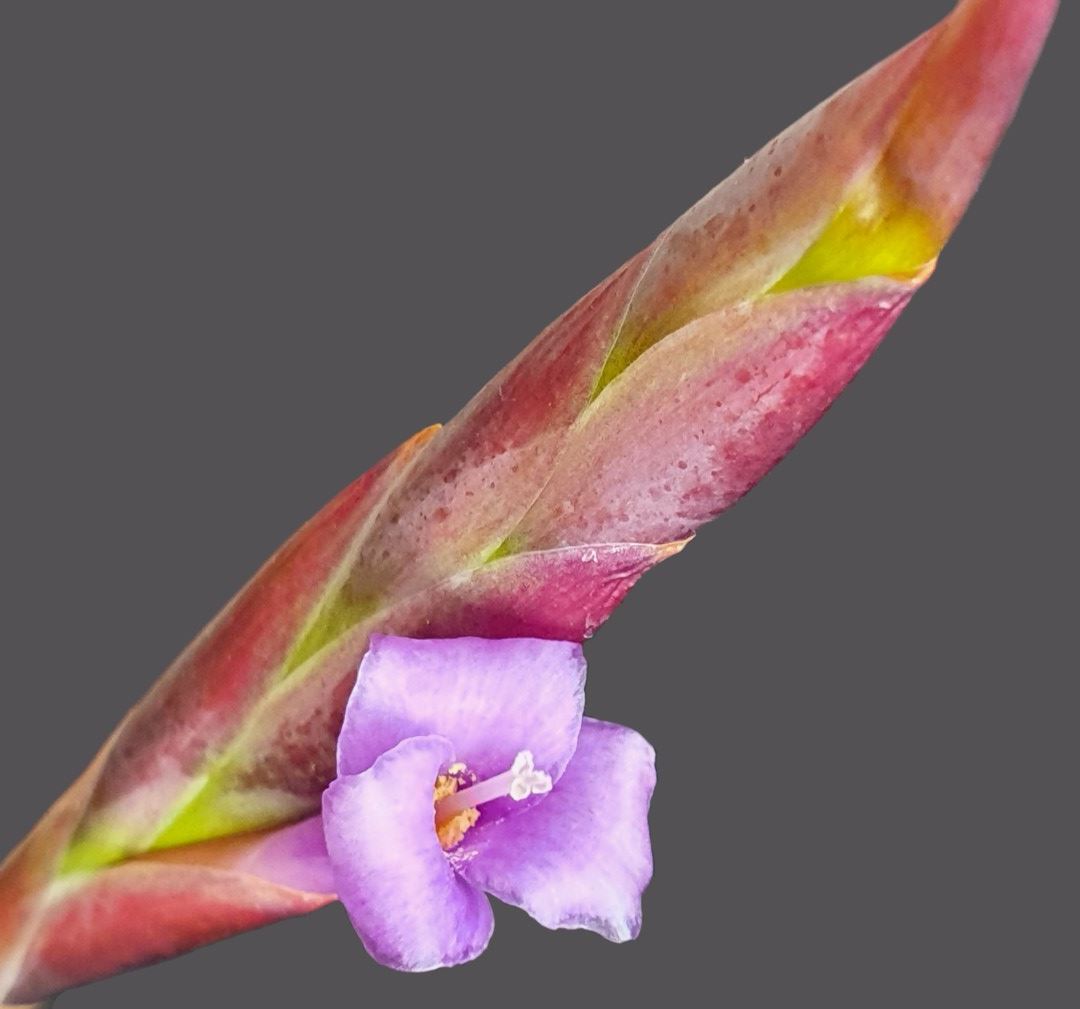
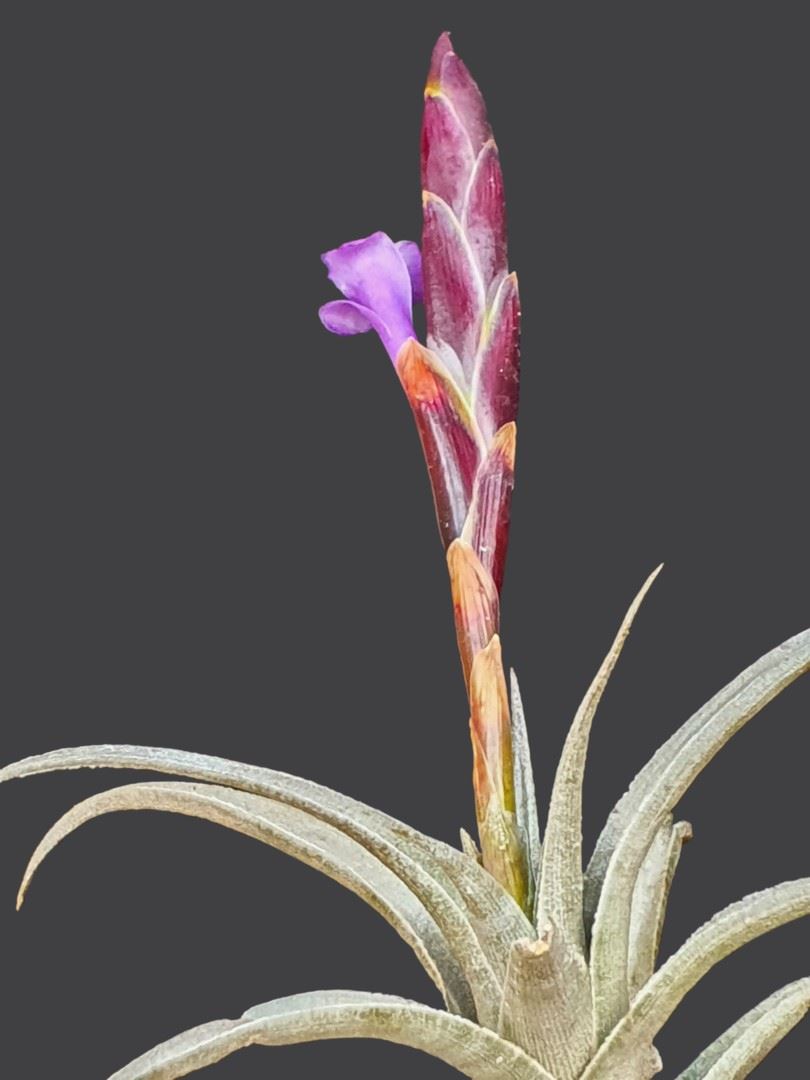
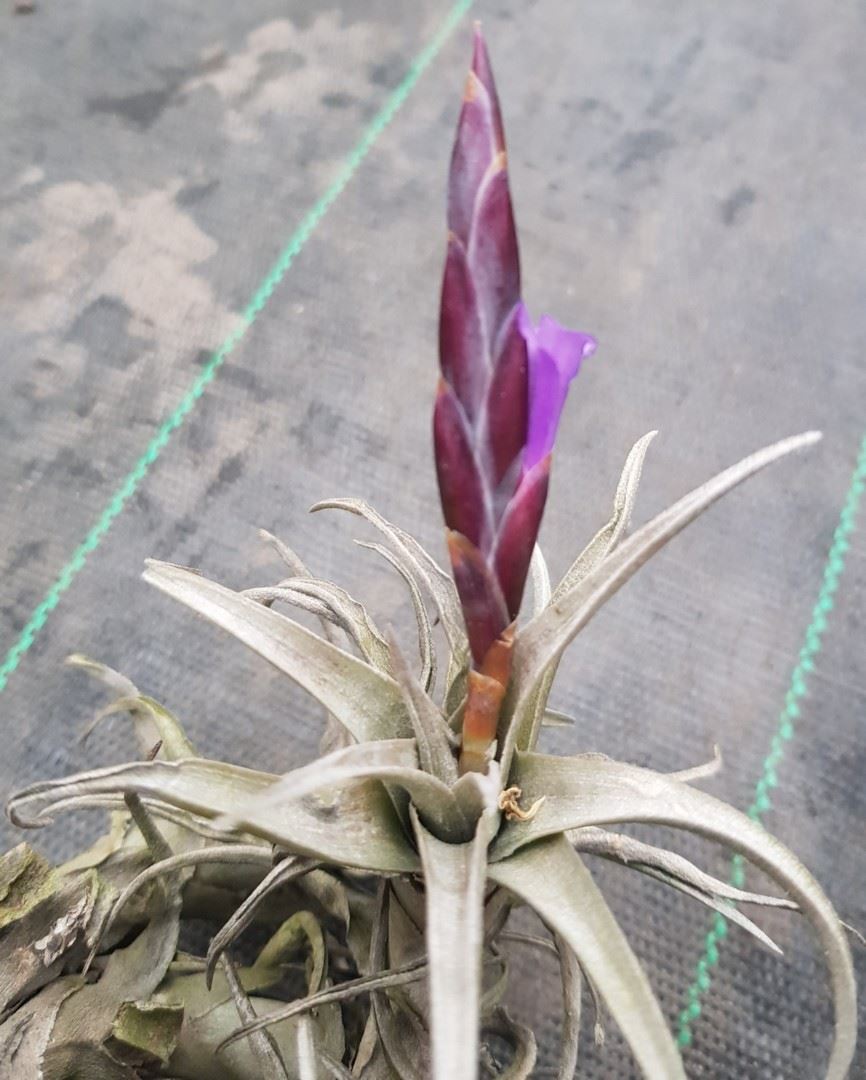
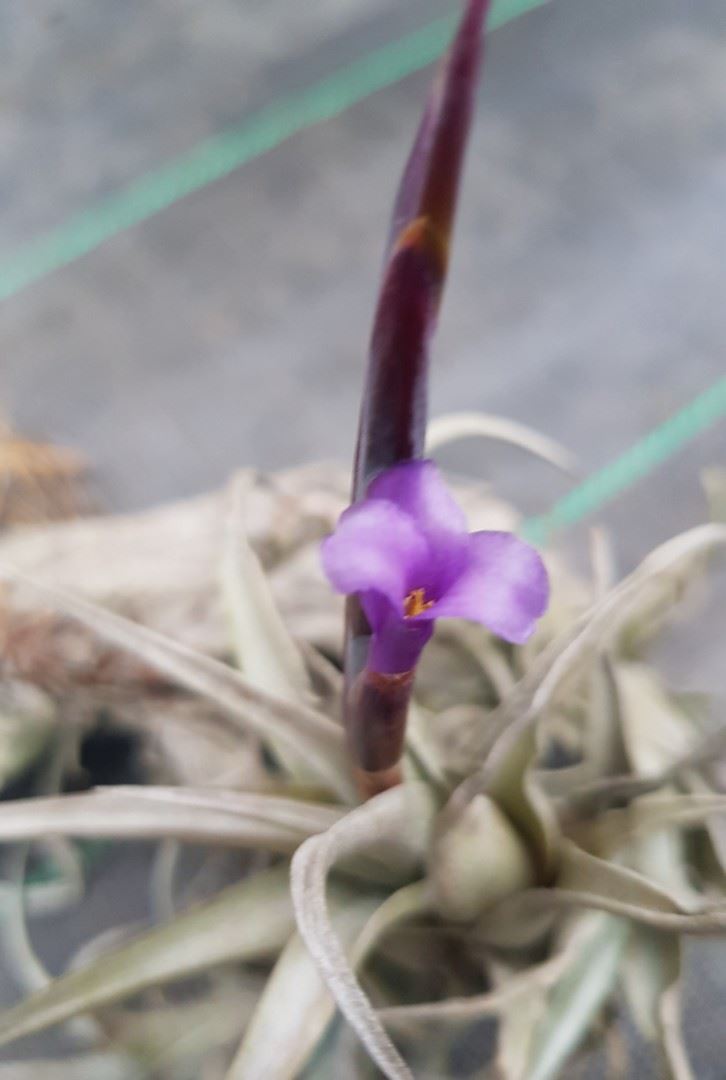
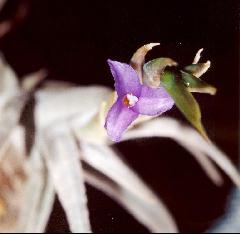
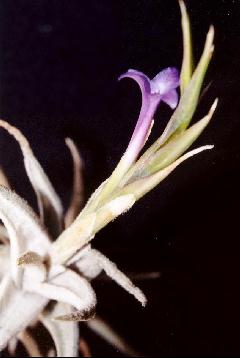
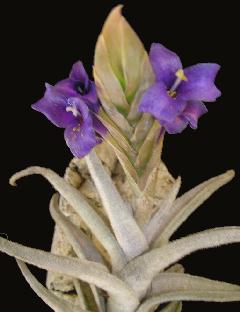
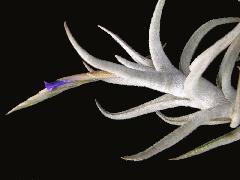
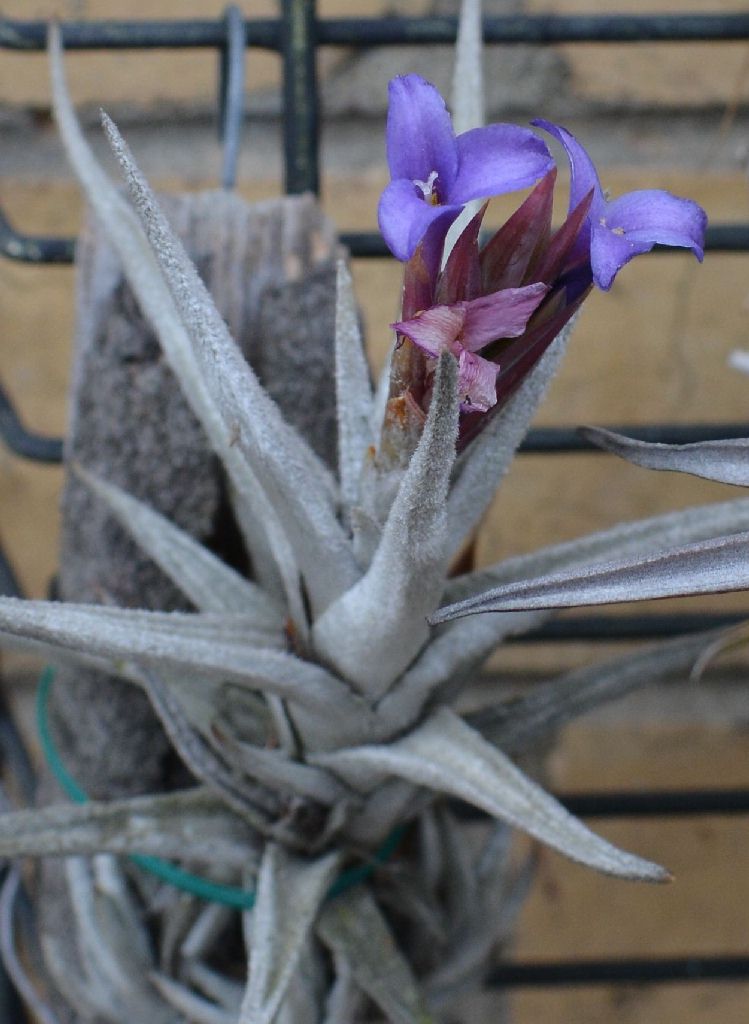
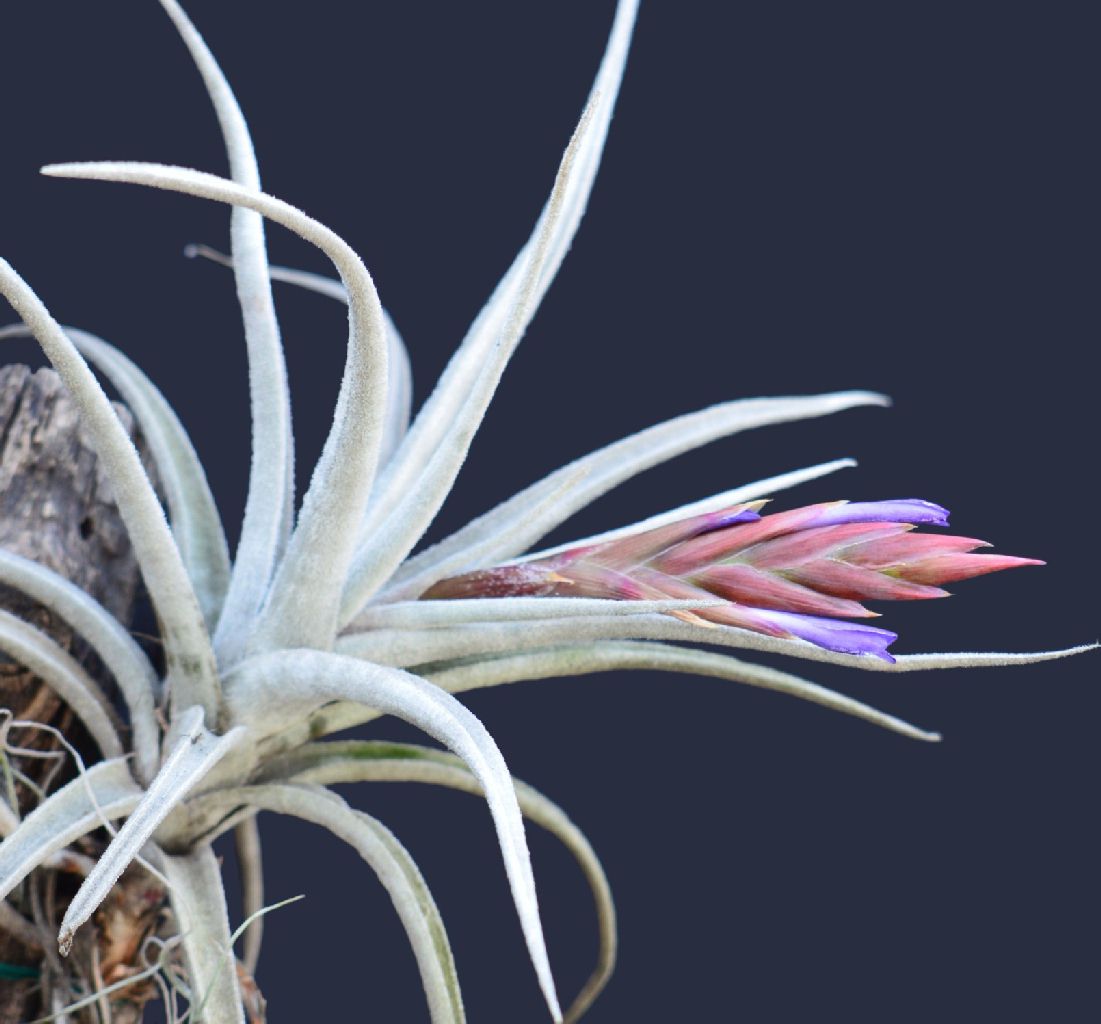
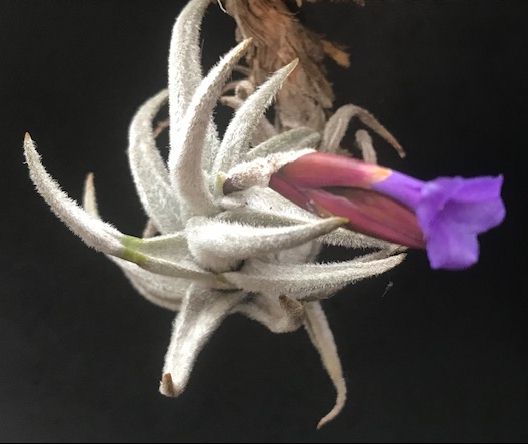
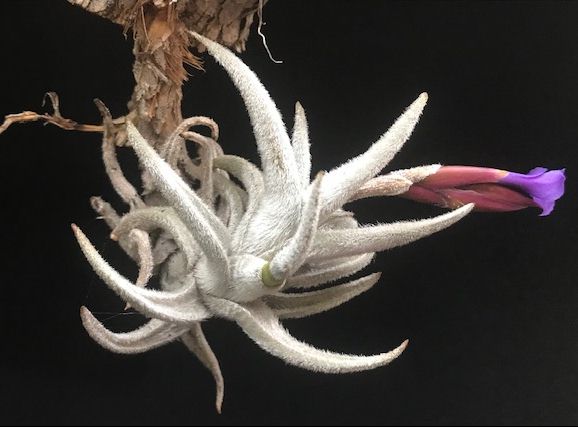
var. brealitoensis |
zecheri |
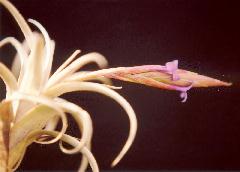
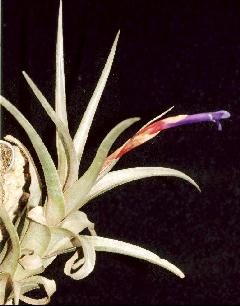
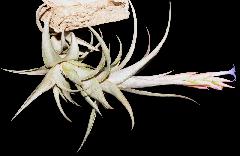
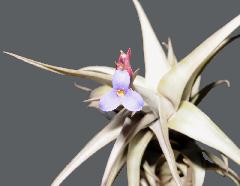
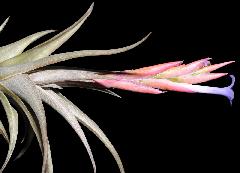
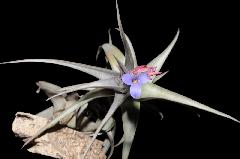
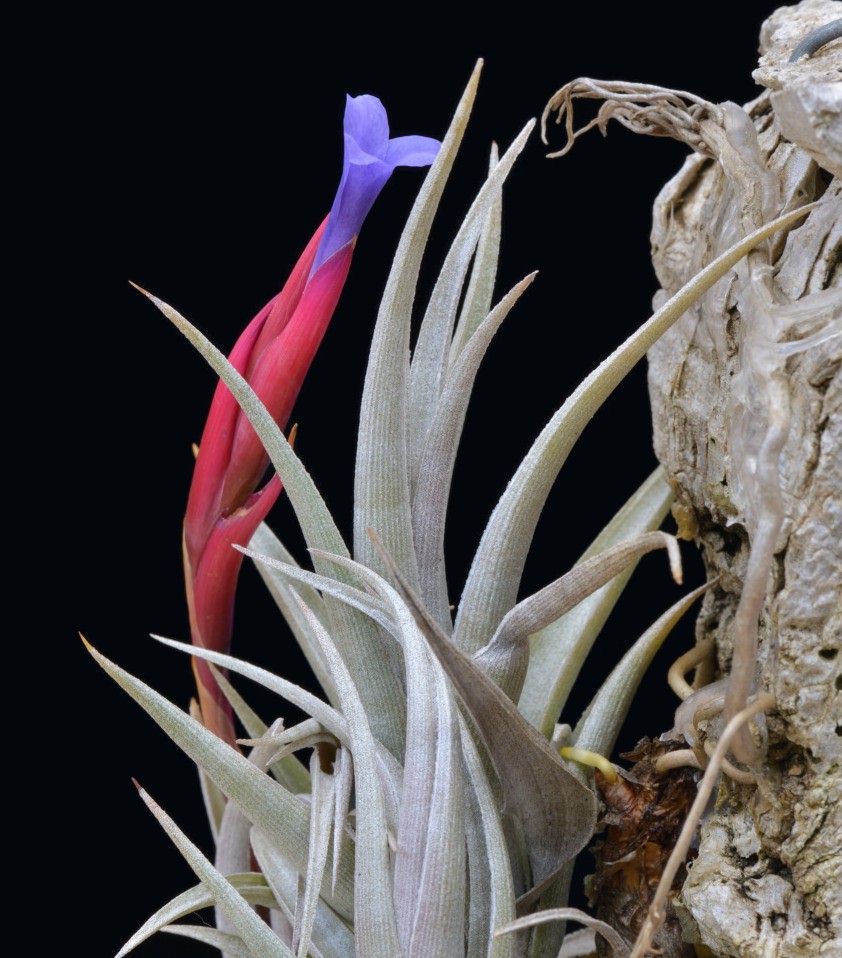
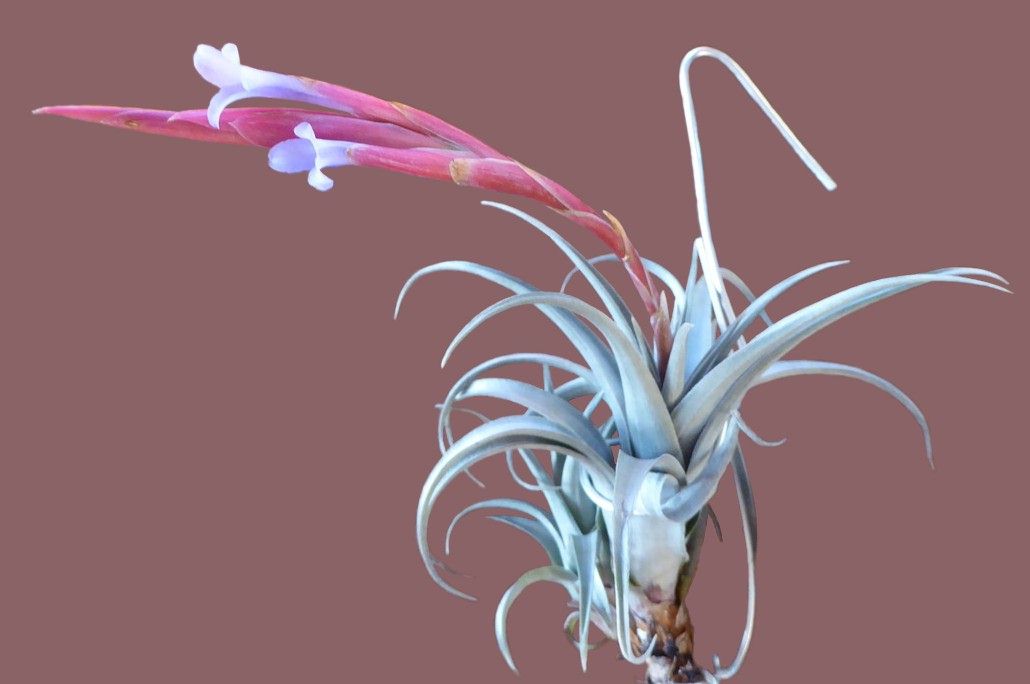
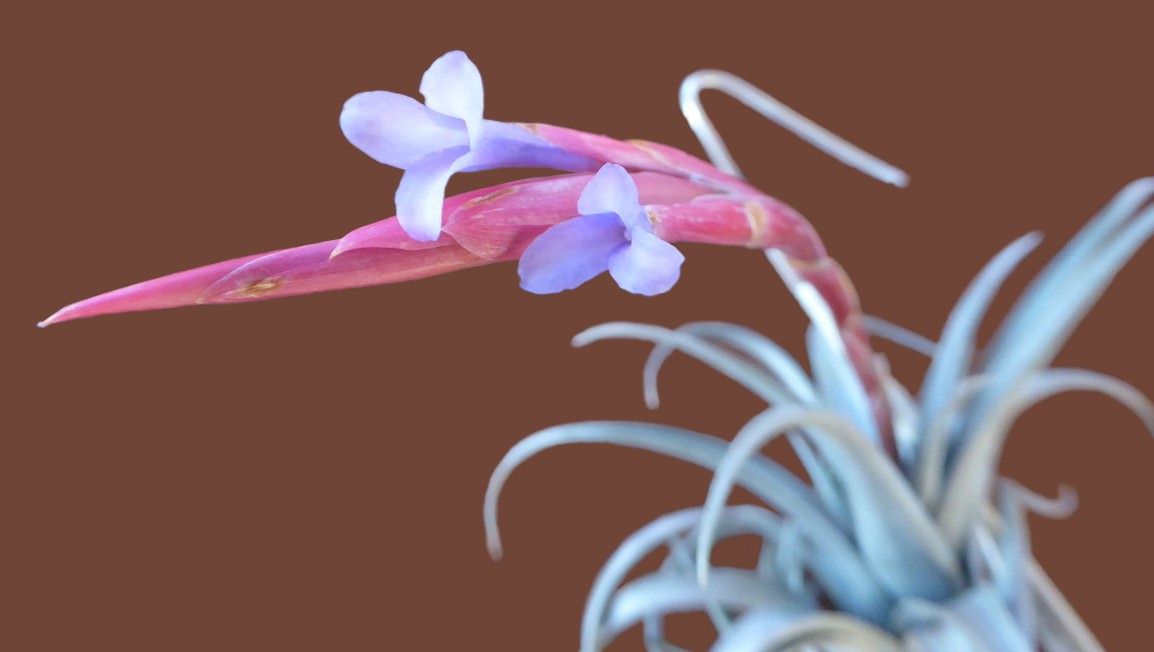
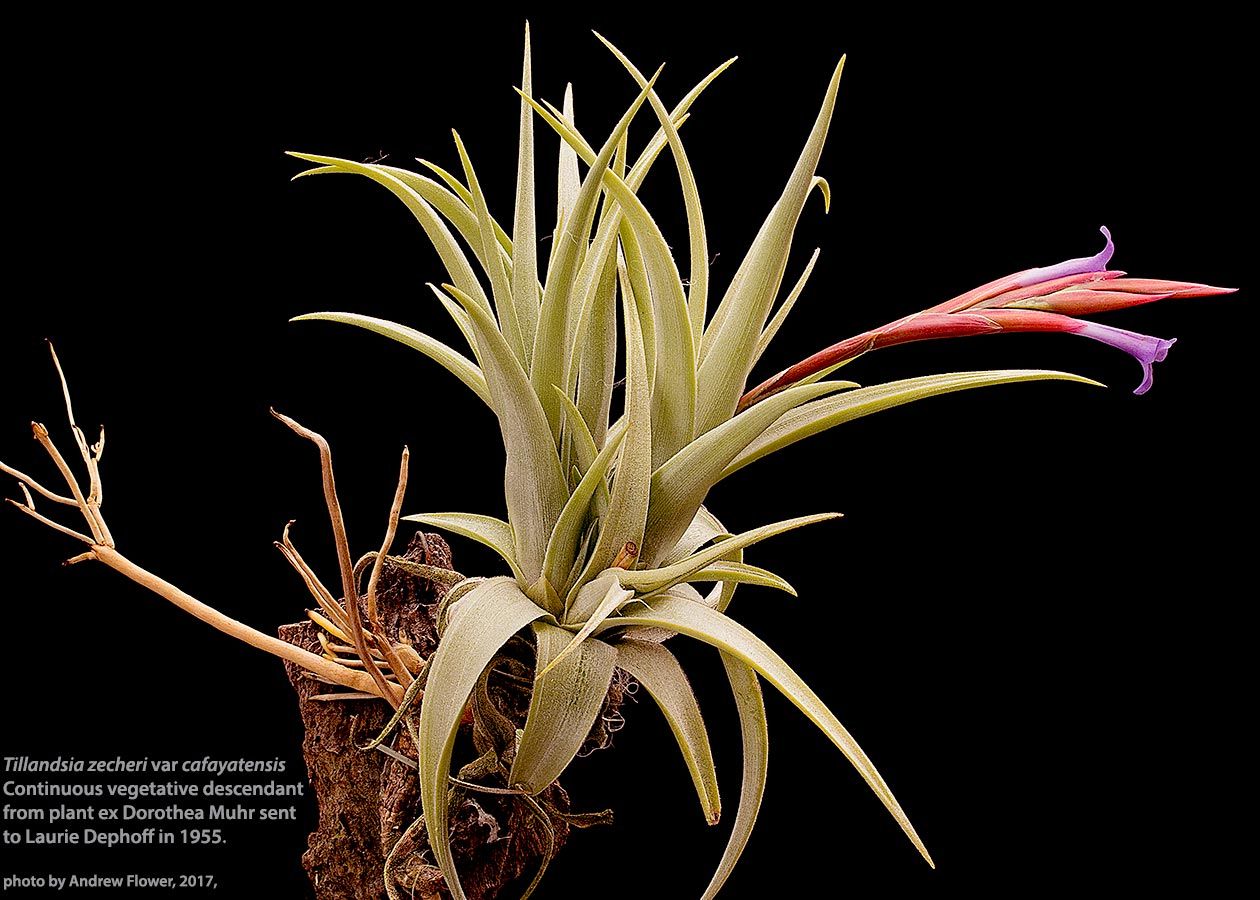
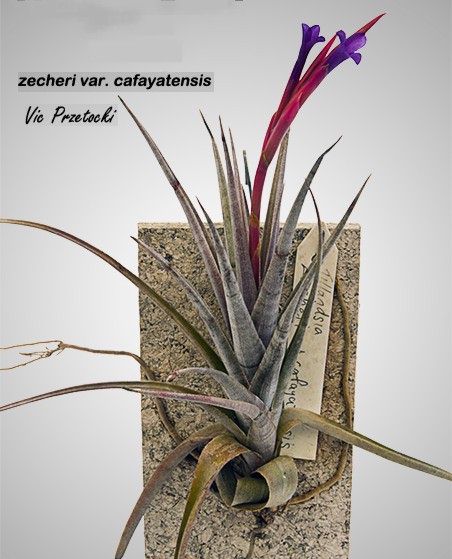
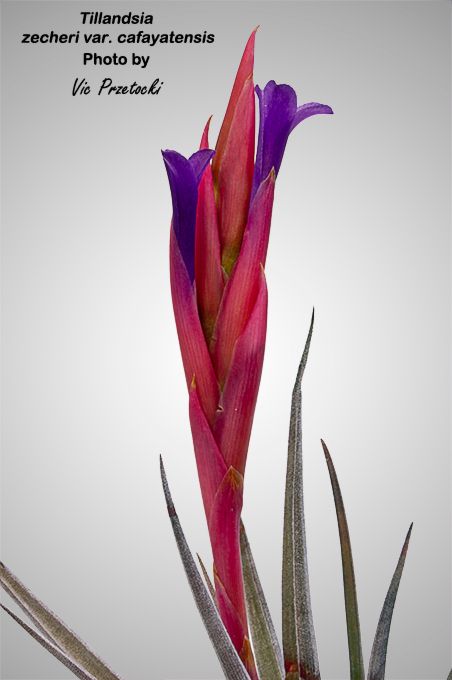
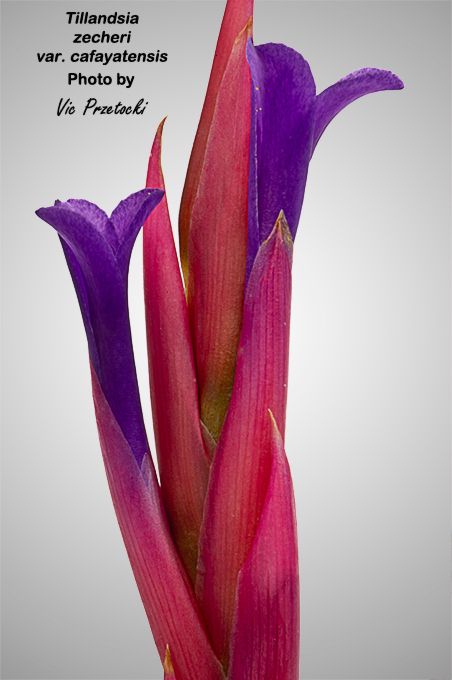
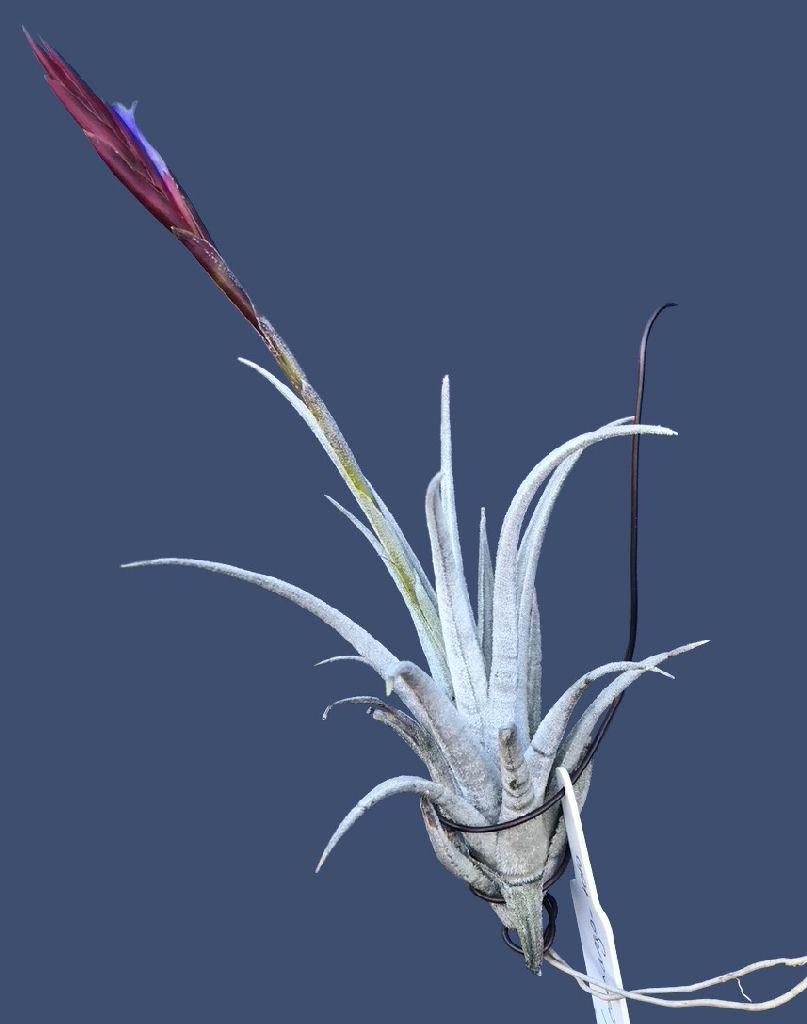
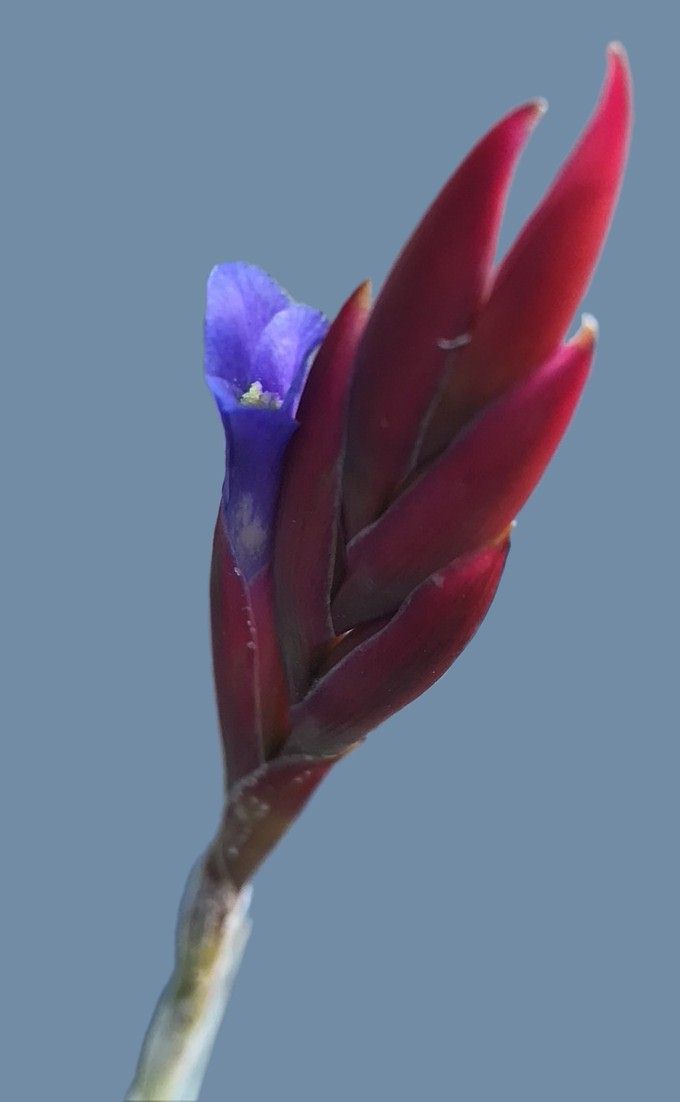
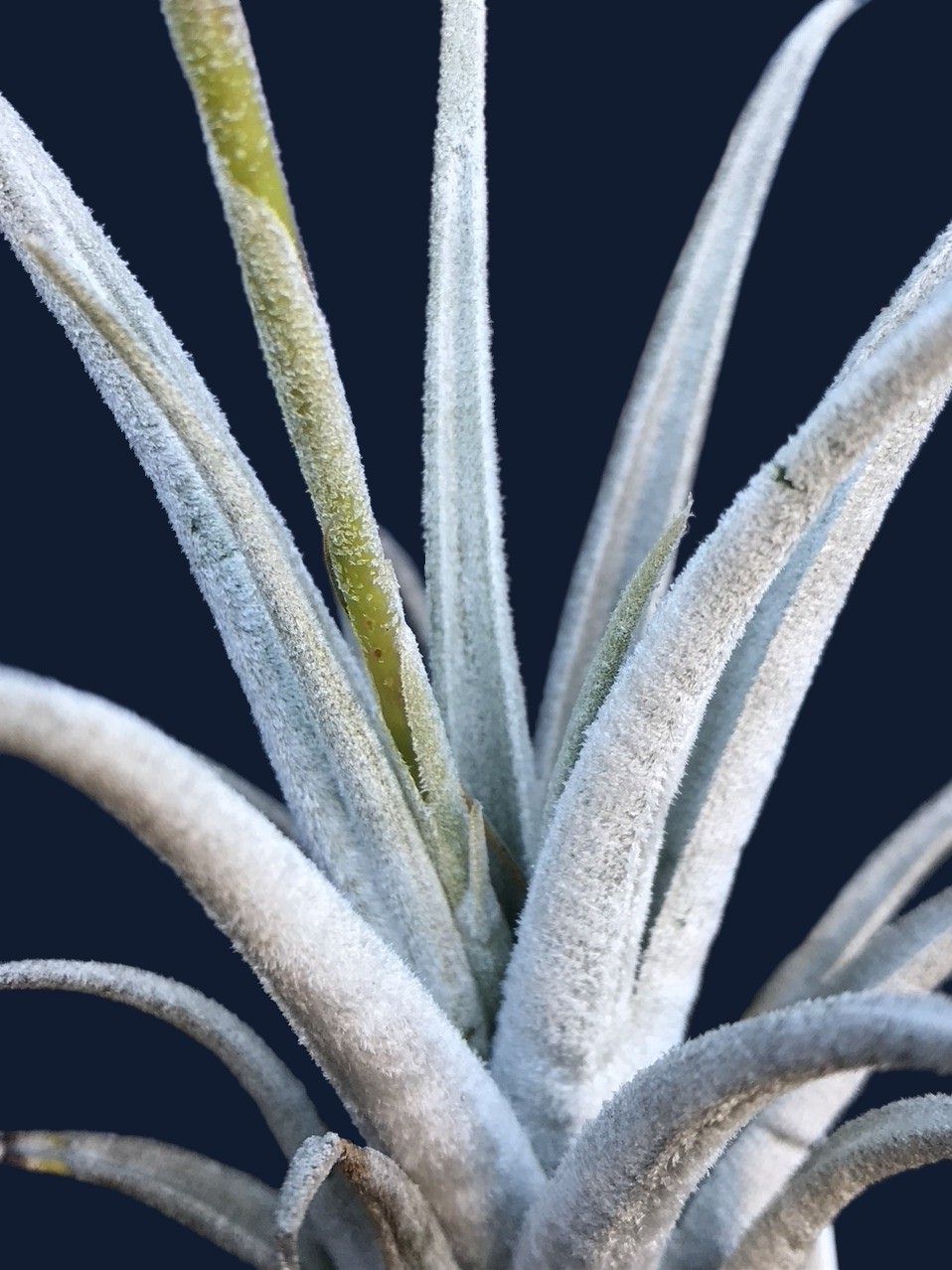
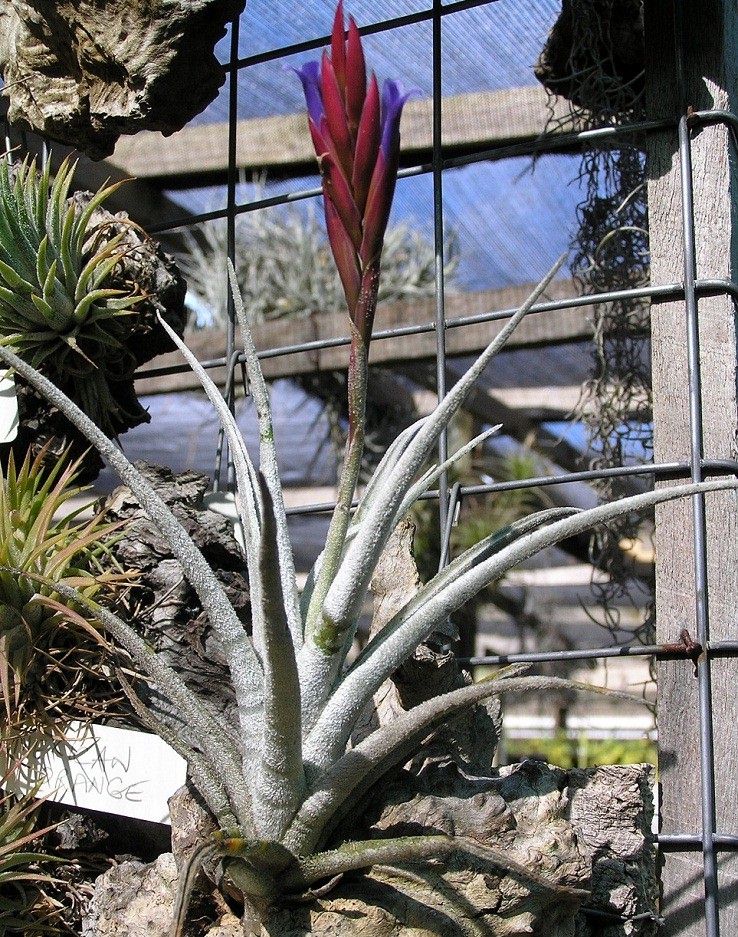
Plant short caulescent;
Leaves erect, sometimes slightly secund;
Leaf sheath indistinct, nerved, lepidote;
Leaf blade narrowly triangular, 13-17 cm long, firm, slightly succulent, obtuse, with involute margins forming a channel on the adaxial surface, densely cinereous lepidote; scales with elongated wings especially at the leaf base.
Scape short, 2-7 cm long, straight or slightly recurved, completely covered by the scape bracts;
Scape bracts lower ones sub foliaceous and grayish, the upper ones lanceolate acute, 30-40 mm long.
Inflorescence simple, complanate, recurved, to 14 cm long, to 3 cm wide, with (3) 4-6 (8) flowers.
Rachis slightly flexuous, laterally compressed, green, glabrous.
Flowers subsessile, 2-3 mm stipitate. not fragrant
Floral bracts reddish, more or less densely imbricate but partially exposing the rachis after anthesis, glabrous, ecarinate, nerved, obtuse, (18) 30-35 (48) mm long, exceeding the sepals.
Sepals oblong-lanceolate, acuminate, equally free, posteriorly carinate, 18-26 mm long, green.
Petals obtuse, lingulate, 37-40 mm long, dark purple-violet.
Stamens about equaling the petal claw at anthesis,
Filaments - slightly plicate in the middle.
Stigma - simple, erect with three lobes (Type I). Stamen and stigma included.
Capsule cylindric, 22 mm long.
Type. H. & L. Hromadnik 7162 (WU). Salta, Valles Calchaquies, Angastaco, Piedra Pintada. 1900 m elev. August 1981.
Additional material examined.
Hromadnik 7163 (WU). Salta, Angastaco, Piedra Pintada. 1900 m elev., 1981. (Cultivated, w. Till 938).
Palaci 1141 (MNCS). Salta, Angastaco, Piedra Pintada, km. 1110, on banks of the Calchaqui River. 1900 m elev., January 6, 1990.
Palaci & Brown 1176 (MCNS, RM). Salta, Finca La Angostura, road from Molinos to Angastaco, km. 1150, July 1990.
The Tillandsia zecheri Complex and a New Infraspecific Taxa from Northwestern Argentina. By Carlos A. Palaci and Gregory K. Brown in J. Brom. Soc. 44(3): 107-116. 1994
Tillandsia zecheri is an interesting, saxicolous plant originally discovered by Dr. W Till in1983 on the banks of the Calchaqui River in the province of Salta, Argentina.
The Calchaqui River drains an extensive, semi-arid region of northwestern Argentina. This river, together with the Rio de Santa Maria and the Rio de las Conchas forms a series of interconnected valleys known as the "Calchaqui valleys" (figure 5). These valleys were occupied by important Indian cultures in the past (Marquez Miranda, 1983) and today represent an important resource for agriculture and tourism.
Also found in the Calchaqui valleys is Tillandsia muhrii. That species was described by Werner Rauh in 1986, who cited the province of Jujuy, locality uncertain, as the type locality. Our field experience indicates, however, that T. muhrii is unlikely to be present in Jujuy, but rather that it is restricted, and probably endemic, to the Calchaqui valleys.
Tillandsia muhrii was named in honor of Dorothea Muhr, a plant collector from Buenos Aires. The name was identified recently as an illegitimate homonym because of its close resemblance with T. muhriae Weber (Till, 1989). As a consequence, this taxon has been left without a legitimate name.
During our field trips into Argentina in December 1989-January 1990 and July-August 1990, we collected samples of both Tillandsia zecheri and T. muhrii. We investigated freshly preserved floral material as well as herbarium specimens in order to determine the systematic position of the latter.
A careful comparison of the original descriptions indicates that the most significant difference between TiIlandsia zecheri and T. muhrii is in their sepals, which were described as "posteriorly carinate" in T. zecheri but "posteriorly ecarinate" in T. muhrii. A close examination of the type specimen of T. muhrii (i.e. D. Muhr T8A) shows somewhat ecarinate sepals. This specimen, however, represents a very immature inflorescence with poorly developed flowers. Another specimen from the same type collection (i.e. D. Muhr T8F), with a well-developed inflorescence, exhibits posteriorly carinate sepals. All of the other specimens of T. muhrii that we have examined so far also have carinate sepals (figure 6).
Another difference between the two taxa is supposed to be the size of the floral bracts and petals. The floral bracts of Tillandsia muhrii were described as being 25 mm long, whereas those of T. zecheri were described as ranging from 18 to 48 mm long. Thus, the length of the floral bracts of T. muhrii falls within the range of variation described for T. zecheri. The petals of T. zecheri range between 37 and 40 mm in length whereas those of T. muhrii were described as being 33 mm long. Our samples of T. muhrii exhibit petals ranging between 28 and 40 mm in length. We observed that these characters tend to vary, within certain limits, among different plants and even within different flowers of a single inflorescence. The color of the petals of both taxa ranges from purple-red to purple-blue passing through different intensities of blue and violet. The flowers of all the plants we have seen in the field are not fragrant.
According to their descriptions, Tillandsia zecheri and T. muhrii differ in their leaf shapes and indumentum. The leaves of T. zecheri are channeled and pruinose lepidote, whereas those of T. muhrii are flat with somewhat appressed scales. The pruinose appearance of T. zecheri is caused mainly by the largely extended wings of the scales (figure 7). However, populations with leaf indumentum and shape characteristics intermediate between T. zecheri and T. muhrii are known (figures 6 and 7). Trichome variability within tillandsioid species is well documented e.g. T. xiphioides Ker-Gawler (Smith & Downs, 1977) and T. utriculata (Gardner, 1983, p. 64. Thus, leaf indumentum and shape characters are not sufficient in distinguishing T. zecheri from T. muhrii.
We conclude on the bases of the similarities of the floral characters, the geographical proximity of the populations, and the plasticity of vegetative features, that there is not enough evidence to support separate species status for T. muhrii. Further support for this conclusion is the presence of intermediate populations that we have collected in the same region (figure 10; Ehlers pers. comm.) Since T. muhrii has been recognized as an illegitimate homonym of T. muhriae Weber, and in order to prevent further confusion with these names, we have decided to establish a new variety (i.e. var. cafayatensis) with a name referring to the typical locality where this taxon is distributed.
In addition, we have collected a specimen from one population in which the leaves are shorter (i.e. (4) 5 (7) cm long) and more rigid than in the typical variety, with a pungent apex and a coarser, strongly pruinose indumentum. The inflorescence is also shorter with only three to four flowers (figure 11). These plants were found close to Brealito and a similar population was detected near Cachi, both above 2500 m elevation. These populations represent, in our opinion, a dwarf form with characteristics that seem to have been fixed through time as an adaptation to extremely dry and stressful conditions at higher elevations in the Andes. The plants are distinct enough to be considered a different form from the typical variety.
W. Till (1983) considered Tillandsia zecheri to be related to T. lorentziana Grisebach and to T. cardenasii L.B. Smith. We have observed, however, that T. lorentziana differs from T. zecheri in its usually compound inflorescence and its smaller flowers with white petals T. cardenasii has very distinct floral bracts and a completely disjunct distribution area in southern Bolivia. As judged by the floral characteristics, other putative relatives to T. zecheri are T. friesii Mez and T. argentina C.H. Wright. The high diversification of habitats and the geographical isolation in distant, narrow valleys may have promoted the evolution of the Andean section of subgenus Anoplophytum in the eastern slopes of the Andes (Palaci, 1991; Till, 1983). Phylogenetic relationships, however, seem to be obscured by rapid evolution and incomplete divergence within this group.
The Tillandsia zecheri complex is restricted and probably endemic to the Calchaqui valleys of Salta, Argentina. Its populations are frequently small and probably fragile because of their restricted habitat on rocky outcrops, which are subjected to frequent erosion by intense rains and river flooding during the summer months. We recommend that collections of these plants be restricted to scientific research, or that careful collection of seeds from ripening fruits be considered.
Tillandsia zecheri W. Till var. zecheri fa. brealitoensis Palaci & G. Brown JBS 1994 p115
A forma typica, foliis rigidioribus et brevioribus (5-7 cm), inflorescentia breviore et pauciflora differt.
Plant dwarf, smaller than the typical form,
Leaves short, (4) 5 (7) cm long, more rigid, sometimes with a pungent apex, channeled, coarsely pruinose lepidote.
Inflorescence short, 7-9 cm long, with 3-4 flowers; Fragrant (! C Larson AUS 2002)
Corolla dark purple-blue.
Type: Palaci & Brown 1172 (RM); isotype (MCNS). Argentina, Salta, Brealito, on the way to the school. On reddish, rocky walls; 2500 m elev. July 27, 1990.
Additional material examined:
Helmut & L. Hromadnik 7154 (WU). Salta, Valles Calchaquies, Brealito, 2350 m elev. Aug. 1981.
0. Irrnstorfer s.n. (WU). Salta, Valles Calchaquies, Payogasta, Feb. 1981 (Cultivated, W. Till 714).
Tillandsia zecheri W. Till var. cafayatensis Palaci & G. Brown JBS 1994 p113-114
Synonym: Tillandsia muhrii Rauh.
A varietate typica foliis tenuioribus et applanatioribus, indumento appresse lepidoto, et inflorescentia graciliore differt; sed plantis intermediis cum ea juncta est.
Leaves 10-12 cm long, less succulent than in the typical variety, flat, appressed lepidote with somewhat symmetrical scales.
Inflorescence somewhat slender and narrower (to 2 cm wide), typically with (4) 6 (8) flowers.
Flowers not fragrant, purple-violet.
Type. Palaci 534 (MCNS); isotype (RM). Argentina, Salta, Dpto. de Guachipas, Garganta del Diablo, 15 mm elev. April 4, 1986.
Additional material examined:
Cabrera & Marchioni 13080 US). Salta, Dpto. Guachipas: Quebrada de las Conchas, Santa Rosa. March 14, 1958.
D. Muhr T8A = B.G.H. 31839 (HElD), "genauer Fundort unbekkant, Prov. Jujuy." May 1973.
D. Muhr T8F = G.B.H. 31835 (US).
Hromadnik 7169 (WU). Salta, Quebrada de Cafayate, Santa Rosa, 1800 m elev., 1981.
Material intermediate between var. zecheri and var. cafayatensis
E. Markus s.n. "Auf erodierten Fels. Cafayate, near Alemania, km 25." (Cultivated, W. Till 951 ).
Helmut & Hromadnik 7167 (WU). Salta, Quebrada de Cafayate, km. 20, 1500 m, Aug. 1981.
Palaci, Marmol & Nunez 1147 (MCNS, RM) Salta, Cafayate, km 20. Jan. 1990.
Palaci & Brown 1178 (MCNS, RM) Salta, Cafayate, km 31, July 1990.
Tillandsia muhrii Rauh, Die Bromelie 2:1-2. 1986 treated by Palaci (1991)as T.’cafayatensis’
Planta breviter caulescens, florens usque ad 15 cm alta; caulis rosula brevior, crassis radicibus et ramosissimis; rosula erecta, usque ad 20 cm alta et 9 cm lata. Vaginae indistincte, usque ad 1,5cm longae et 1,5 cm latae, subalbae, utrimque dense apresso-lepidotae. Lamina usque ad 7 cm longa et 1,3 cm lata, plana, anguste triangula, acuminata neque vero longe attenuata, utrimque densissime lepidota; lepides non omnio appressae neque vero centro brunneo divaricantes. Inflorescentia simplex (an semper?) arcuate incurva, usque ad 9 cm longa. Scapus 4 cm longus, erecte curvatus, omnio circumdatus bracteis scapi, quarum basales sunt subfoliatae et canae, quarum superiores sunt vaginiformes et scapum omnio amplectuntur. Bracteae scapi mediae sordide-rubrae, gla¬brae, valde nervatae, membranaceo acumine et mature desiccante; bracteae scapi superiores paulatim transeuntes in bracteas florigeras. Inflorescentia complanata, 4 cm longa et 0,6 cm lata, plus minusve 5 flores gerens; bracteae florigerae erecte oblongo-lanceolatae, 2,5 cm longae, acuminatae, 6 mm latae, carmineae, glabrae, valde nervatae, ecarinatae, multo longiores quam sepala et ea ampletentes. Rhachis spicae flexuosa, a latere applanata, viridis, glabra. Flores subsessiles usque ad 3,5 cm longi. Sepala oblongo-lanceolata, acuminata, posteriora ecarinata, subrubra, ad basim viridia, glabra, desiccata, valde ecarinata. Petala erecta, usque ad 33 mm longa et 3 cm lata, apicibus divaricantibus et luculente caeruleo-rubro-violaceis. Stamina et stylus profunde inclusa; filamenta vix plicata.
Holotypus: Dorothea MUHR T 8a = B.G.H, 31 839 (Mai 1973), in herb.inst.syst.bot. heidelb. (HEID).
Habitat et distrlbutio: Prov. Juju, loco incerto, Argentinia.
Plant - Short caulescent, flowering to 15cm high. Stem shorter than rosette, with very robust and abundantly branched roots. Rosette upright to 20cm high and 9cm wide. All leaves spreading, the younger ones erect.
Leaf sheath - Indistinct, to 1.5cm long, 1.2cm wide, whitish both sides, dense appressed lepidote.
Leaf blade - To 7cm long, 1.3cm wide, flat, thin, 3 angled towards the tip but not long attenuate, both sides very thick white lepidote; scales spreading with brownish centre.
Inflorescence - Simple (? always), bent, to 9cm long.
Scape - 4cm long, erect to bent, totally covered by scape bracts whose base is subfoliate, the middle sheath enveloping the whole scape, grey lepidote.
Scape bracts - the middle ones dirty red, naked, strongly veined, with membranous soon drying tips. The upper scape bracts gradually flow over to the flowers.
Spike - Complanate, 4cm long, 0.6cm wide, ca 5 flowered.
Floral bracts - Erect, long lancelike, 2.5cm long, acuminate, 6mm wide, carmine-red, naked, strongly veined, ecarinate, much longer than the sepals and almost enclosing them.
Rhachis - Flexible, flattened on the side, green, naked.
Flower - Almost sessile, to 3.5cm long.
Sepal - Long lancelike, acuminate, the posterior ones ecarinate, reddish, the bottom green, naked, with strong nerves when dry.
Petal - Erect to 33mm long, 3mm wide, with spreading blunt tips, bright red blue/violet.
Stamens - and style lobes enclosed. Filament weakly plicate.
Type - Holotype: Dorothea Muhr T. 8a = BGH 31 839 (May 1973) HEID
HABITAT - From Province of Jujuy, Argentina: without exact locality.
Differs from T. lorentziana as follows :
Plant much smaller, flowering to about 20cm high
Leaves not long attenuate
Upper scape bracts glabrous
Inflorescens simple (?always)
Floral bracts widely exceeding the sepals
Petals light blue violet and the tip bent over compared to T. lorentziana where they are white and erect
Many of us will know by now that Len Colgan, the current President of the Bromeliad Society of S.A. Inc., spent a few weeks in South America in early 1988 looking for bromeliads. I found that the most interesting part was when he found himself in the arid areas around Tucuman and Jujuy in Argentina. When a person correctly pronounces Jujuy as Hewey Hewey it is confusing but that's another story.
Some who have seen Len's slides of his trip may have been taken in by his comment that a specimen of Tillandsia xiphioides that isn't there anymore because of some greedy collector. It is at present in quarantine in Adelaide!
What might this have to do with this article ? - you may ask !
You will be aware that Tillandsia xiphioides has an extra large white flower, although the botanical drawing does not show it that big, and if you saw the slide, it is epiphytic. The variety tafiensis has smaller flowers which are a lavender shade and the plant is much more silvery or fuzzy and lives mainly on rocks. As an aside you may be aware that intrepid Len did not find this variety and in fact stayed at the local inn in Tafi without realising the significance of the name of the village !
Perhaps I should now quote from Paul Isley's paper to the 1982 World Bromeliad Conference in Corpus Christi.
"South of Salta we found a xiphioides-like plant, this is still unknown to us. It was found at only one remote location. Upon inspection, it is quite different to Tillandsia xiphioides. There are not so many leaves, the plant is somewhat smaller, and the leaves are not as succulent as Tillandsia xiphioides. The plants were discovered growing saxicolously. The leaf colour, although tending to brown like Tillandsia xiphioides, was a little silver, and in many, more red because of trichome absorption of the surrounding red clay dust.
The scape bracts, unlike the pale beige of Tillandsia xiphioides are bright red, and the petals are tongue-shaped and blue. It is a wonderful plant, well worth having. It must be rare in cultivation. This plant probably has a name but at the moment I do not know what it is".
Since that time apparently Professor Rauh has named this plant Tillandsia muhrii. The fact that it is a beautiful plant is confirmed by Paul Isley's recent book on Tillandsias.
Back to the Butcher link! In 1982 when in the U.S.A. I obtained a Tillandsia friesii from Rainforest which is run by Paul Isley. In 1986 I imported more tillandsias but this time the batch included a Tillandsia muhrii. I couldn't tell the difference and my plants showed no relations to the line drawings in Smith & Downs of Tillandsia friesii. Even when I wrote Paul Isley his reply was non committal. I suppose that in hindsight I really couldn't expect a nurseryman to agree that his names could be wrong.
In any event both my Tillandsia friesii and my Tillandsia muhrii have now flowered and they are all Tillandsia muhrii. So if anyone has a true Tillandsia friesii I will gladly swap with one super duper, rare Tillandsia muhrii.
Finally, you may say why did I bring Tillandsia xiphioides var. tafiensis into this. Well, I believe that the true plant is in South Australia and that Maurie Kellett's plant in Victoria is probably a Tillandsia muhrii. Come to the Bromeliad Convention in Melbourne for the next exciting instalment of this fascinating journey of discovery.
Tillandsia muhrii by Harry E. Luther Director, BIC; U.S., Bromeletter 27(1):8-9. 1989
Re: Tillandsia muhrii by Derek Butcher, Bromeletter Vol.26 No.4 1988.
The story of T. xiphioides var tafiensis is one of more than average confusion and uncertainty. The last word on this may still to be written. I have been interested in this plant since 1979, have contributed to the horticultural confusion and hopefully now will be able to clear up some of the problems associated with this taxon.
At least five Tillandsia taxa are involved in this saga. They are T. xiphioides Ker-Gawler, 1816; T. xiphioides var. tafiensis L.B. Smith, 1970; T. friesii Mez, 1906; T. zecheri Till, 1983; and T. muhrae Weber, 1986.
The first, T. xiphioides var. xiphioides is well known and widely cultivated. It is a small plant with hard, succulent leaves densely covered with APPRESSED silvery trichomes, the leaves appear more or less smooth. The flowers are large and white. There is little confusion with the typical variety.
T. xiphioides var. tafiensis is another story. In 1979 I visited the National Herbarium at the Smithsonian Institution to microfilm all the bromeliad types for reference at the BIC. I was able to closely examine the type of var. tafiensis. This sheet consists of three elements; two complete plants on the left of the sheet, a single, detached inflorescence with good flowers on the right. The left hand and the right hand elements did not appear to belong together. I filed this bit of information away with several other noncritical problems to be dealt with at some later date.
At the World Bromeliad Conference in 1982 at Corpus Christi., Texas, I obtained from Paul Isley two interesting Argentine tillandsias. The first was a somewhat fuzzy form of otherwise typical T. xiphioides. The second was a smaller, darker plant with closely appressed trichomes, a more slender scapose inflorescence with red bracts and violet flowers. Paul stated that both had been identified as T. xiphioides var. tafiensis but they were clearly not the same. He called the fuzzy one T. xiphioides "var. tafiensis" and the smooth, purple-flowered plant T. xiphioides "variant". I obtained several of each for the research collection of the Marie Selby Botanical Gardens.
In January of 1984 I again visited the Smithsonian Institution, this time to work on specific problem taxa and review certain critical types. I compared the type specimen of T. xiphioides var. tafiensis with both of Paul Isley's plants and immediately could see that the type specimen consisted of two separate elements and that each of these compared closely with Paul's two "xiphioides". The left hand elements (2 complete plants) was the same as the fuzzy var. tafiensis from Paul. The single inflorescence appeared to be the same as the purple-flowered "variant". In other words the type specimen consists of a MIXED COLLECTION and the original description is mixed as well. What is to be done? The simple and correct solution to this problem is to exclude the right hand element as it obviously is not conspecific with T. xiphioides and restrict the definition of var. tafiensis to characters exhibited by the two left hand elements as they are clearly conspecific with T. xiphioides and differ only in trichome morphology. The two varieties of T. xiphioides should be distinguished as follows:
* var. xiphioides Trichomes appressed with broad lobes, leaves appearing smooth.
* var. tafiensis Trichomes spreading with narrow lobes, leaves appearing tomentose.
At some point between 1982 and 1986 I suggested to Paul that his T. xiphioides "variant" had nothing to do with true T. xiphioides and was probably related to or even the same as T. friesii.
At this point in time T. friesii was a very poorly known species, the SINGLE collection from 1901 was not available to me and the only material at my disposal was a poor photo and a drawing besides the written description. Paul Isley’s plant was identified as being close to or the same as T. friesii by the "best match" method. When in doubt I usually take a conservative stand and tentatively "lump" instead of erecting new species. All during this time I had a gut feeling that Paul's purple flowered plant was new but as better material of T. friesii that more clearly matched the type was not in cultivation and no other collections of this species had appeared in herbaria, matters remained in this state until early 1986.
Sometime in the spring of 1986 Paul announced that he had rediscovered true T. friesii in Argentina. Several living plants soon arrived to verify this statement. It was now clear that the purple-flowered "variant" was new.
Before I could even contemplate describing this new tillandsia I received word (a rumour at best) that it was already named. I finally was able to track down the rumour and obtained a critical copy of Die Bromelie 1/2 1983 where Walter Till describes T. zecheri. This species seems to correspond both to Paul's purple-flowered 'variant' and to the right hand excluded element on the type sheet of T. ziphioides var. tafiensis.
Here matters rested until late 1987.
Just prior to Christmas 1987 I received a complimentary copy of Paul Isley's magnificent book on the genus Tillandsia. Included was a treatment of a T. muhrii Rauh, a plant very similar if not identical to T. zecheri. I can find no record of this name ever having been published by Dr. Rauh or anyone else. I do have a citation for a T. muhrae Weber published in Feddes Repertorium 97 (3-4) March 1986 which may be based on this same taxon. Unfortunately I have not been able to secure a copy of this publication to verify the identity of this proposed species. It may or may not be a synonym of the earlier T. zecheri.
So where do we stand now in regard to names for all of these plants?
Tillandsia xiphioides var. xiphioides is not a problem.
Tillandsia xiphioides var. tafiensis is in limited cultivation & can be distinguished by its fuzzy or scurfy appearance; it is otherwise very similar to typical T. xiphioides,
T. friesii is also now in limited cultivation and should not present any real problem
T. zecheri is in my opinion the correct name for the purple-flowered "variant" . It is fairly common in cultivation.
T. muhrae is at present a mystery and MAY BE synonymous with T. zecheri. Time will tell.
My comments covering the last two species may change as more information becomes available so use a pencil for your labels.